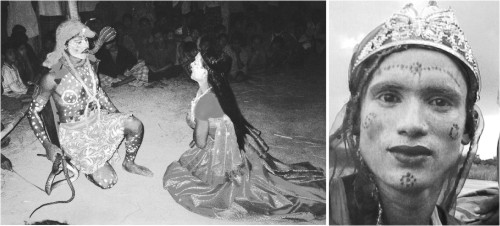| From Tangail
The Seasonal Dance
Saymon Zakaria

IN the villages of Bangladesh, the rainy season has its own festivals. One of them centres around the snake goddess Manasa. The story of two mortals are tied inextricably to this goddess- they are Behula and Laxmindar. As the mythology goes- Manasa, via Shiva came to Laxmindar's father Chandsowdagor to collect his puja. It was said that if Chandsowdagor offered puja to Manasa, Manasa-puja would be established in the world. However, Chand was reluctant to do so. As a result, Manasa got thirsty for revenge and killed Chand's seven children one by one. As for the last child, Laxmindar- there was a curse on him. The curse was that Laxmindar would be killed by a snake attack on the marital bed. In order to protect Laxmindar from that curse, Manasa built a marital room out of iron for him. But that wouldn't stop Manasa of course, she managed to send a snake over to his marital bed and kill Laxmindar. After this, the widow Behula took Laxmindar's dead body over to the temples and pacified the gods and brought Laxmindar back to life. This story is remembered every year on the month of Srabon in Tangail. These dance plays are held along the banks of rivers in Tangail's Kalihati, Bhuiyanpur and Gopalpur thanas.
 The story is basically retold through song and dance. Most of the artistes involved in these performances are low income, low educated Muslims. Usually these are performed during the Manasa puja of Srabon Shonkranti. Besides this, throughout the year, whenever someone is bitten by a snake or someone is in danger, an arrangement is made for a Behula dance. The story is basically retold through song and dance. Most of the artistes involved in these performances are low income, low educated Muslims. Usually these are performed during the Manasa puja of Srabon Shonkranti. Besides this, throughout the year, whenever someone is bitten by a snake or someone is in danger, an arrangement is made for a Behula dance.
This is usually done out in the front yard of a house or wherever there is a wide open space. The performance takes about 20 square feet with four trees or bamboo poles in each corner. The stage is set. The audience sits around the square.
The performers usually sit in the yard of a nearby house on a mat on the floor and get into costume and makeup. While they are getting dressed, they usually have with them some water and some coconut oil.
They use these on their faces and bodies to apply the makeup. To make the colour, they use zinc oxide of different colours such as red, yellow, blue and white. The character of Mahadev applies white spots all over his body and a lot of elaborate clothing, parts of it made of snake skin and tiger skin. The performers playing females enter a room of one of the houses and come out fully dressed. There's plenty of variety in the sort of thing the performers wear. The character of Shiva, for example, is usually in bare torso. He wraps something that looks like tiger skin around him- this goes down to his knees.
 A lot of props are used in the performance. This includes a live snake, a gamcha, a silver water pitcher, a fishing rod, mirrors, spectacles, combs, matches, cigarettes and so on. A lot of props are used in the performance. This includes a live snake, a gamcha, a silver water pitcher, a fishing rod, mirrors, spectacles, combs, matches, cigarettes and so on.
In Tangail, even though this performance is in the form of singing and dancing, there is certainly a script-base and descriptive performance. Although one might discern some influence of jatra on the dialogue, jatra doesn't really influence the style of the performance. The actors often dig so deep into their performances they sometimes embrace one another and fall to the ground or even lose consciousness. Even when this happens, the show goes on.
The narrator plays a crucial role. He comes up on stage and starts telling the story- he can sum up a lot of things pretty quickly. In a way he controls the tempo of the performance- he can speed up his narration if he wants to. Conversely, he can slow it down.
In the beginning there's instrumental music. After this, the Ustad and three or four people playing the roles of women and the character of Laxmindar enter and start singing Bandanageet. During this, the performers turn to whatever direction the words come from and dance to the rhythm. After this is over the performers leave the stage, the Ustad enters and narrates some more. This type of ashor usually shows the birth of Padmadevi. After the narrator mentions the birth of Padmadevi and leaves, Shiva enters. And so it goes, in all its varieties.
Under the leadership of Ustad Rustom Ali (50) and Manager Abdul Karim (55) from Tangail's Kalihati thana, farmers, small entrepreneurs, tea sellers, rickshaw-van drivers from Haripur, Betduba, Satkua, Naraingel, Nawabari, Kasturipara and Hamidpur have been recruited to perform. There is another group that performers from Bhuiyanpur thana, Singuria village headed by Ustad Abdul Halim (28) and Manager Yousuf (45). All these groups perform in the last week of Srabon.

Copyright
(R) thedailystar.net 2009
|
|
